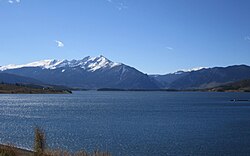Dillon Reservoir
| Dillon Reservoir | |
|---|---|

Dillon Reservoir in October
|
|
| Location |
Summit County, Colorado, United States |
| Coordinates | 39°36′27″N 106°03′18″W / 39.6074°N 106.0551°WCoordinates: 39°36′27″N 106°03′18″W / 39.6074°N 106.0551°W |
| Type | Reservoir |
| Primary inflows | Blue River |
| Basin countries | United States |
| Surface area | 3,233 acres (1,308 ha) |
| Water volume | 250,000 acre feet (310,000,000 m3) |
| Shore length1 | 26.8 miles (43.1 km) |
| Surface elevation | 9,017 feet (2,748 m) |
| 1 Shore length is not a well-defined measure. | |
Dillon Reservoir, sometimes referred to as Lake Dillon, is a large fresh water reservoir located in Summit County, Colorado, south of I-70 and bordered by the towns of Frisco, Silverthorne, and Dillon. It is a reservoir for the city of Denver, and its waters are under the control of Denver Water. Popular ski areas are close to the reservoir, including Copper Mountain, Keystone, Arapahoe Basin, and Breckenridge.
In 1859, a large party of gold-seekers led by Ruben Spalding discovered gold near the headwaters of the Blue River, which prompted a population surge in Summit County, Colorado. By October 1859, nearly 100 miners had camped along the river. By 1880, the human population of Summit county had swelled to 5,459. In 1881, Dillon Mining Company patented a 320-acre parcel and divided it into lots to establish the trade-post town of Dillon along the northeast bank of the Snake River, which is part of what was then called Blue River Valley. The town of Dillon was incorporated in 1883, but soon relocated to the west bank of the Blue River when Denver and Rio Grand Railroad came to Blue River Valley but had bypassed Dillon. Dillon was moved a second time in 1892 when the Denver, South Park and Pacific Railroad arrived from the northeast. The town was located at the confluence of three rivers: the Blue, Tenmile Creek and the Snake to provide one station for the two railroad lines. In 1890, Dillon's population was 133, less than 20% as large as Breckenridge at the time. Prior to its third move to the present location in 1961, the town had grown to 814 residents, the largest town in Summit County, however, most of this population consisted of construction workers for the dam.
The idea to dam the Blue River and divert the water to Denver originated in the early 1900s. Denver Water Board acquired most of the land needed for the reservoir for the price of back taxes during the Great Depression when many Dillon residents were unable to pay property taxes. By then, Denver Water Board had already acquired most of the water rights in the valley. In 1956, Denver Water Board notified the remaining residents and business owners they must sell and leave by September 15, 1961. Dam construction began in 1961 and was completed in 1963. The dam is earth-filled, 5,888 feet (1795m) long, and rises 231 feet (70m) above the Blue River stream bed. The dam was completed in 1963.
...
Wikipedia
